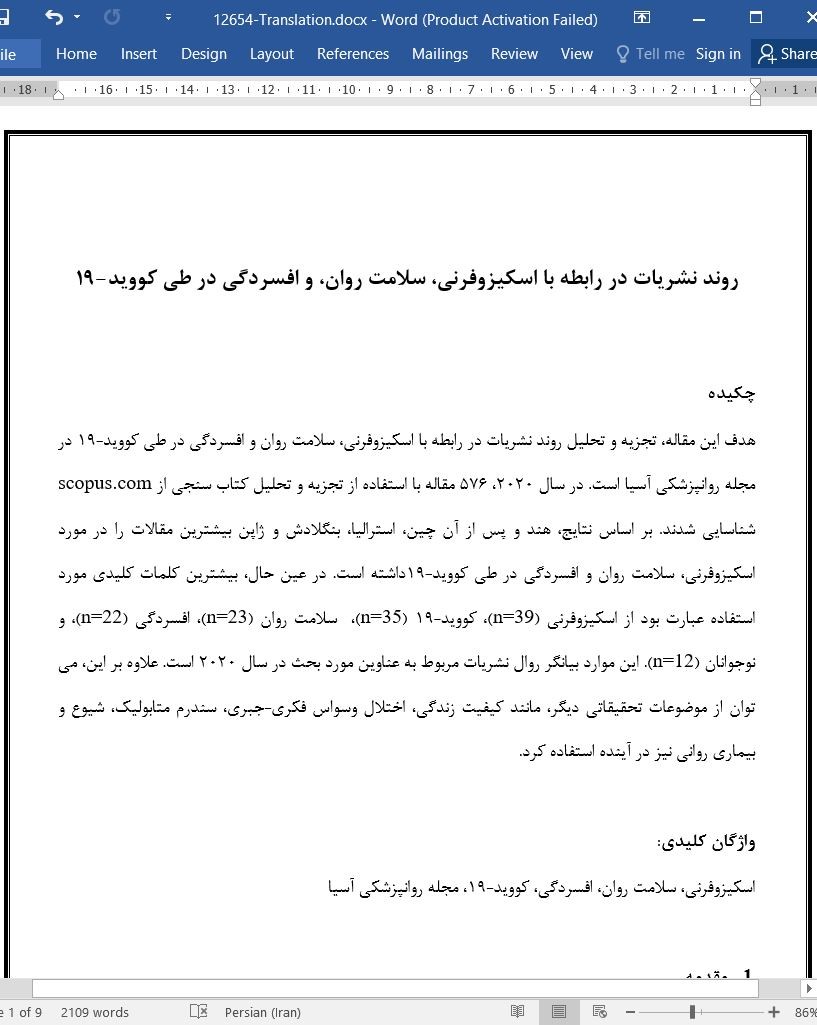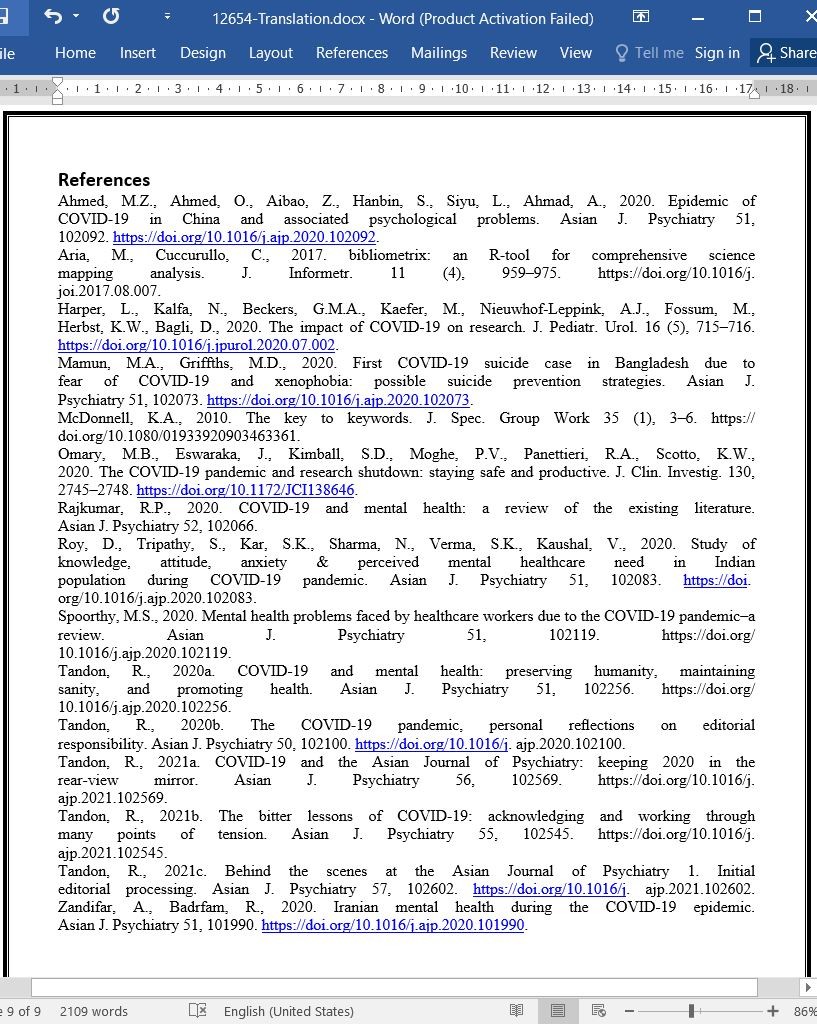
روند نشریات در رابطه با اسکیزوفرنی، سلامت روان، و افسردگی در طی کووید-19
چکیده
هدف این مقاله، تجزیه و تحلیل روند نشریات در رابطه با اسکیزوفرنی، سلامت روان و افسردگی در طی کووید-19 در مجله روانپزشکی آسیا است. در سال 2020، 576 مقاله با استفاده از تجزیه و تحلیل کتاب سنجی از scopus.com شناسایی شدند. بر اساس نتایج، هند و پس از آن چین، استرالیا، بنگلادش و ژاپن بیشترین مقالات را در مورد اسکیزوفرنی، سلامت روان و افسردگی در طی کووید-19داشته است. در عین حال، بیشترین کلمات کلیدی مورد استفاده عبارت بود از اسکیزوفرنی (n=39)، کووید-19 (n=35)، سلامت روان (n=23)، افسردگی (n=22)، و نوجوانان (n=12). این موارد بیانگر روال نشریات مربوط به عناوین مورد بحث در سال 2020 است. علاوه بر این، می توان از موضوعات تحقیقاتی دیگر، مانند کیفیت زندگی، اختلال وسواس فکری-جبری، سندرم متابولیک، شیوع و بیماری روانی نیز در آینده استفاده کرد.
1. مقدمه
کووید-19 تأثیر قابل توجهی بر همه طبقات از جمله در تحقیقات و انتشارات علمی گذاشته است (Harper و همکاران، 2020). علاوه بر این، مقرراتی که با هدف کاهش خطر گسترش وضع شده اند، در حال اجرا هستند که بر تعداد انتشارات علمی تأثیر گذاشته اند (Omary و همکاران، 2020). از سوی دیگر، تعداد نشریات مرتبط با کووید-19 در حال افزایش است. بر این موارد شیوع کووید-19 در نقاط مختلف نیز افزایش یافته است. در نتیجه، نقش انتشار علمی، در این مورد، مجلات، برای کمک به ارائه اطلاعات معتبر و به موقع در مورد کووید-19 حائز اهمیت است (Tandon ، 2020b). علاوه بر این، مجله روانپزشکی آسیا روحیه حفظ انسانیت، حفظ سلامت عقل و ارتقای سلامت را اتخاذ کرده است (Tandon ، 2020a)، که ما آن را بسیار تحسین می کنیم. تصمیمات سردبیر که دارای مفاهیم هوشمندانه ای در مورد تصمیمات و مقررات مجله در رابطه با عملکرد مجله در کاهش شیوع کووید-19 است، باید به عنوان یک منبع الهام بخش برای مجلات دیگر استفاده شود. و ضمن حفظ کیفیت بالای مجله و اهداف بشردوستانه، به مرجعی برای مسائل مربوط به کووید-19و سلامت روان تبدیل می شود (Tandon ، 2021b).
Abstract
The aim of this article is to analyze publication trends related to schizophrenia, mental health, and depression during COVID-19 in the Asian Journal of Psychiatry. In 2020, 576 articles were identified using bibliometric analysis from scopus.com. According to the results, India had the most articles on schizophrenia, mental health, and depression, followed by China, Australia, Bangladesh, and Japan, during COVID-19. Meanwhile, the most frequently used keywords were schizophrenia (n = 39), COVID-19 (n = 35), mental health (n = 23), depression (n = 22), and adolescents (n = 12). These represent the trend of publications related to the topics discussed in 2020. Moreover, alternative research themes such as life quality, obsessive-compulsive disorder, metabolic syndrome, prevalence, and mental illness can be used in the future.
1. Introduction
COVID-19 has had a significant impact across the board, including research and scientific publications (Harper et al., 2020). Moreover, regulations aimed at reducing the risk of spread are being implemented which have an impact on the number of scientific publishing (Omary et al., 2020). On the other hand, the number of COVID-19 related publications is increasing. Based on this, cases of the COVID-19 spread in various locations have also risen. As a result, the role of scientific issuing, in this case, journals, is needed to aid in the provision of valid and timely information about COVID-19 (Tandon, 2020b). Additionally, the Asian Journal of Psychiatry has adopted the spirit of preserving humanity, maintaining sanity, and promoting health (Tandon, 2020a), which we greatly appreciate. Editorial decisions that have smart concepts about journal decisions and regulations related to the journal’s function in mitigating the spread of COVID-19 should be used as inspiration for other journals. While maintaining the journal’s high quality and humanitarian goals, it becomes a reference for issues related to COVID-19 and mental health (Tandon, 2021b).
چکیده
1. مقدمه
2. روش
3. نتایج و بحث
3.1. تجزیه و تحلیل نمودار سه قسمتی انجام شده است: نویسنده، کشور نویسنده و کلمات کلیدی.
3.2. سهم نویسنده
3.3. رایج ترین کلمات کلیدی و تحقیقات آینده بر اساس دامنه هدف مجله
4. نتیجه گیری
منابع
ABSTRACT
1. Introduction
2. Method
3. Results and discussion
3.1. Three-field plot analyses are performed: the author,author’s country, and keywords
3.2. The author’s contribution
3.3. The most frequent keywords and future research based on the journal’s aim scope
4. Conclusion
References
- اصل مقاله انگلیسی با فرمت ورد (word) با قابلیت ویرایش
- ترجمه فارسی مقاله با فرمت ورد (word) با قابلیت ویرایش، بدون آرم سایت ای ترجمه
- ترجمه فارسی مقاله با فرمت pdf، بدون آرم سایت ای ترجمه



